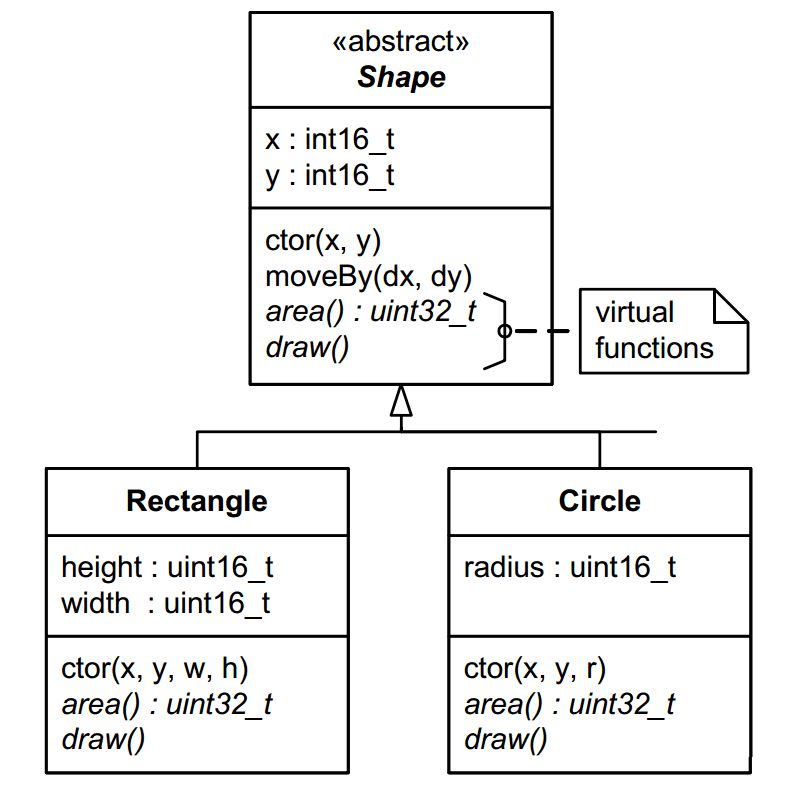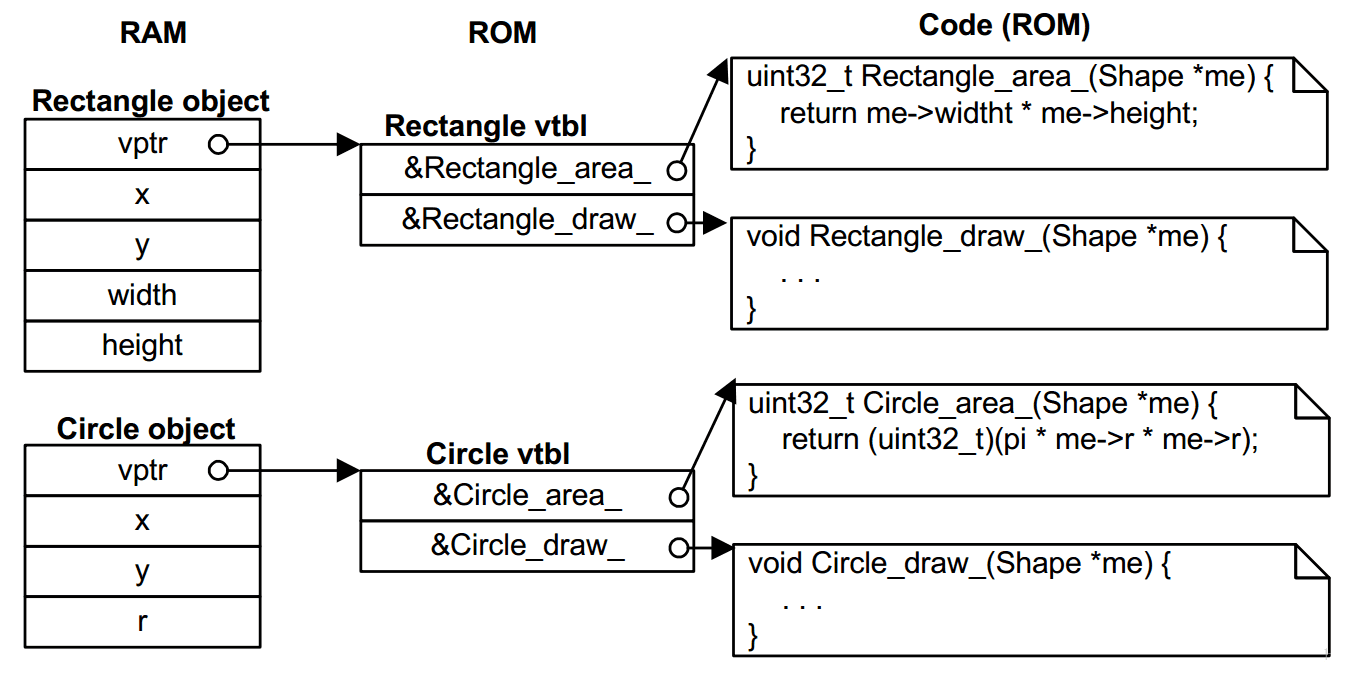| 编辑推荐: |
本文主要讲解了用 C 语言实现封装、继承 、多态等内容,希望本文对大家有帮助。
文章来自于博客园,由火龙果Anna编辑推荐。 |
|
1、引言
面向对象编程(OOP)并不是一种特定的语言或者工具,它只是一种设计方法、设计思想。它表现出来的三个最基本的特性就是封装、继承与多态。很多面向对象的编程语言已经包含这三个特性了,例如
Smalltalk、C++、Java。但是你也可以用几乎所有的编程语言来实现面向对象编程,例如 ANSI-C。要记住,面向对象是一种思想,一种方法,不要太拘泥于编程语言。
2、封装
封装就是把数据和方法打包到一个类里面。其实C语言编程者应该都已经接触过了,C 标准库
中的 fopen(), fclose(), fread(), fwrite()等函数的操作对象就是
FILE。数据内容就是 FILE,数据的读写操作就是 fread()、fwrite(),fopen()
类比于构造函数,fclose() 就是析构函数。这个看起来似乎很好理解,那下面我们实现一下基本的封装特性。
#ifndef SHAPE_H
#define SHAPE_H
#include <stdint.h>
// Shape 的属性
typedef struct {
int16_t x;
int16_t y;
} Shape;
// Shape 的操作函数,接口函数
void Shape_ctor (Shape * const me, int16_t x,
int16_t y);
void Shape_moveBy (Shape * const me, int16_t
dx, int16_t dy);
int16_t Shape_getX (Shape const * const me);
int16_t Shape_getY (Shape const * const me);
#endif /* SHAPE_H */ |
这是 Shape 类的声明,非常简单,很好理解。一般会把声明放到头文件里面 “Shape.h”。
来看下 Shape 类相关的定义,当然是在 “Shape.c” 里面。
#include "shape.h"
// 构造函数
void Shape_ctor (Shape * const me, int16_t x,
int16_t y)
{
me->x = x;
me->y = y;
}
void Shape_moveBy (Shape * const me, int16_t
dx, int16_t dy)
{
me->x += dx;
me->y += dy;
}
// 获取属性值函数
int16_t Shape_getX(Shape const * const me)
{
return me->x;
}
int16_t Shape_getY(Shape const * const me)
{
return me->y;
} |
再看下 main.c
#include "shape.h"
/* Shape class interface */
#include <stdio.h> /* for printf() */
int main()
{
Shape s1, s2; /* multiple instances of Shape
*/
Shape_ctor(&s1, 0, 1);
Shape_ctor(&s2, -1, 2);
printf ("Shape s1(x=%d,y=%d)\n",
Shape_getX(&s1), Shape_getY(&s1));
printf ("Shape s2(x=%d,y=%d)\n", Shape_getX(&s2),
Shape_getY(&s2));
Shape_moveBy(&s1, 2, -4);
Shape_moveBy(&s2, 1, -2);
printf (" Shape s1(x=%d,y=%d)\n",
Shape_getX(&s1), Shape_getY(&s1));
printf("Shape s2(x=%d,y=%d)\n", Shape_getX(&s2),
Shape_getY(&s2));
return 0;
} |
编译之后,看看执行结果:
Shape s1(x=0,y=1)
Shape s2(x=-1,y=2)
Shape s1(x=2,y=-3)
Shape s2(x=0,y=0)
|
整个例子,非常简单,非常好理解。以后写代码时候,要多去想想标准库的文件IO操作,这样也有意识的去培养面向对象编程的思维。
3、继承
继承就是基于现有的一个类去定义一个新类,这样有助于重用代码,更好的组织代码。在 C 语言里面,去实现单继承也非常简单,只要把基类放到继承类的第一个数据成员的位置就行了。
例如,我们现在要创建一个 Rectangle 类,我们只要继承 Shape 类已经存在的属性和操作,再添加不同于
Shape 的属性和操作到 Rectangle 中。
下面是 Rectangle 的声明与定义:
#ifndef RECT_H
#define RECT_H
#include "shape.h" // 基类接口
// 矩形的属性
typedef struct {
Shape super; // 继承 Shape
// 自己的属性
uint16_t width;
uint16_t height;
} Rectangle;
// 构造函数
void Rectangle_ctor (Rectangle * const me, int16_t
x, int16_t y,
uint16_t width, uint16_t height);
#endif /* RECT_H */ |
#include "rect.h"
// 构造函数
void Rectangle_ctor(Rectangle * const me, int16_t
x, int16_t y,
uint16_t width, uint16_t height)
{
/* first call superclass’ ctor */
Shape_ctor(&me->super, x, y);
/* next, you initialize the attributes added
by this subclass... */
me->width = width;
me->height = height;
} |
我们来看一下 Rectangle 的继承关系和内存布局

因为有这样的内存布局,所以你可以很安全的传一个指向 Rectangle
对象的指针到一个期望传入 Shape 对象的指针的函数中,就是一个函数的参数是 “Shape *”,你可以传入
“Rectangle *”,并且这是非常安全的。这样的话,基类的所有属性和方法都可以被继承类继承!
#include "rect.h"
#include <stdio.h>
int main()
{
Rectangle r1, r2;
// 实例化对象
Rectangle_ctor(&r1, 0, 2, 10, 15);
Rectangle_ctor(&r2, -1, 3, 5, 8);
printf("Rect r1(x=%d,y=%d,width=%d,height=%d)\n",
Shape_getX(&r1.super), Shape_getY(&r1.super),
r1.width, r1.height);
printf("Rect r2(x=%d,y=%d,width=%d,height=%d)\n",
Shape_getX(&r2.super), Shape_getY(&r2.super),
r2.width, r2.height);
// 注意,这里有两种方式,一是强转类型,二是直接使用成员地址
Shape_moveBy((Shape *)&r1, -2, 3);
Shape_moveBy(&r2.super, 2, -1);
printf("Rect r1(x=%d,y=%d,width=%d,height=%d)\n",
Shape_getX(&r1.super), Shape_getY(&r1.super),
r1.width, r1.height);
printf("Rect r2(x=%d,y=%d,width=%d,height=%d)\n",
Shape_getX(&r2.super), Shape_getY(&r2.super),
r2.width, r2.height);
return 0;
} |
输出结果:
Rect r1(x=0,y=2,width=10,height=15)
Rect r2(x=-1,y=3,width=5,height=8)
Rect r1(x=-2,y=5,width=10,height=15)
Rect r2(x=1,y=2,width=5,height=8)
|
4、多态
C++ 语言实现多态就是使用虚函数。在 C 语言里面,也可以实现多态。
现在,我们又要增加一个圆形,并且在 Shape 要扩展功能,我们要增加 area() 和 draw()
函数。但是 Shape 相当于抽象类,不知道怎么去计算自己的面积,更不知道怎么去画出来自己。而且,矩形和圆形的面积计算方式和几何图像也是不一样的。
下面让我们重新声明一下 Shape 类
#ifndef SHAPE_H
#define SHAPE_H
#include <stdint.h>
struct ShapeVtbl;
// Shape 的属性
typedef struct {
struct ShapeVtbl const *vptr;
int16_t x;
int16_t y;
} Shape;
// Shape 的虚表
struct ShapeVtbl {
uint32_t (*area)(Shape const * const me);
void (*draw)(Shape const * const me);
};
// Shape 的操作函数,接口函数
void Shape_ctor (Shape * const me, int16_t x,
int16_t y);
void Shape_moveBy (Shape * const me, int16_t
dx, int16_t dy);
int16_t Shape_getX (Shape const * const me);
int16_t Shape_getY (Shape const * const me);
static inline uint32_t Shape_area(Shape const
* const me)
{
return (*me->vptr->area)(me);
}
static inline void Shape_draw (Shape const
* const me)
{
(*me->vptr->draw)(me);
}
Shape const *largestShape (Shape const *shapes[],
uint32_t nShapes);
void drawAllShapes (Shape const *shapes[], uint32_t
nShapes);
#endif /* SHAPE_H */ |
看下加上虚函数之后的类关系图

4.1 虚表和虚指针
虚表(Virtual Table)是这个类所有虚函数的函数指针的集合。
虚指针(Virtual Pointer)是一个指向虚表的指针。这个虚指针必须存在于每个对象实例中,会被所有子类继承。
在《Inside The C++ Object Model》的第一章内容中,有这些介绍。
4.2 在构造函数中设置vptr
在每一个对象实例中,vptr 必须被初始化指向其 vtbl。最好的初始化位置就是在类的构造函数中。事实上,在构造函数中,C++
编译器隐式的创建了一个初始化的vptr。在 C 语言里面, 我们必须显示的初始化vptr。
下面就展示一下,在 Shape 的构造函数里面,如何去初始化这个 vptr。
#include "shape.h"
#include <assert.h>
// Shape 的虚函数
static uint32_t Shape_area_(Shape const * const
me);
static void Shape_draw_(Shape const * const
me);
// 构造函数
void Shape_ctor(Shape * const me, int16_t x,
int16_t y)
{
// Shape 类的虚表
static struct ShapeVtbl const vtbl =
{
&Shape_area_,
&Shape_draw_
};
me->vptr = &vtbl;
me->x = x;
me->y = y;
}
void Shape_moveBy(Shape * const me, int16_t
dx, int16_t dy)
{
me->x += dx;
me->y += dy;
}
int16_t Shape_getX(Shape const * const me)
{
return me->x;
}
int16_t Shape_getY(Shape const * const me)
{
return me->y;
}
// Shape 类的虚函数实现
static uint32_t Shape_area_(Shape const * const
me)
{
assert(0); // 类似纯虚函数
return 0U; // 避免警告
}
static void Shape_draw_(Shape const * const
me)
{
assert(0); // 纯虚函数不能被调用
}
Shape const *largestShape (Shape const *shapes[],
uint32_t nShapes)
{
Shape const *s = (Shape *)0;
uint32_t max = 0U;
uint32_t i;
for (i = 0U; i < nShapes; ++i)
{
uint32_t area = Shape_area(shapes[i]);// 虚函数调用
if (area > max)
{
max = area;
s = shapes[i];
}
}
return s;
}
void drawAllShapes (Shape const *shapes[], uint32_t
nShapes)
{
uint32_t i;
for (i = 0U; i < nShapes; ++i)
{
Shape_draw(shapes[i]); // 虚函数调用
}
} |
注释比较清晰,这里不再多做解释。
4.3 继承 vtbl 和 重载 vptr
上面已经提到过,基类包含 vptr,子类会自动继承。但是,vptr
需要被子类的虚表重新赋值。并且,这也必须发生在子类的构造函数中。下面是 Rectangle 的构造函数。
#include "rect.h"
#include <stdio.h>
// Rectangle 虚函数
static uint32_t Rectangle_area_ (Shape const
* const me);
static void Rectangle_draw_(Shape const * const
me);
// 构造函数
void Rectangle_ctor (Rectangle * const me, int16_t
x, int16_t y,
uint16_t width, uint16_t height)
{
static struct ShapeVtbl const vtbl =
{
&Rectangle_area_,
&Rectangle_draw_
};
Shape_ctor(&me->super, x, y); // 调用基类的构造函数
me->super.vptr = &vtbl; // 重载 vptr
me->width = width;
me->height = height;
}
// Rectangle's 虚函数实现
static uint32_t Rectangle_area_ (Shape const
* const me)
{
Rectangle const * const me_ = (Rectangle const
*)me; //显示的转换
return (uint32_t)me_->width * (uint32_t)me_->height;
}
static void Rectangle_draw_ (Shape const * const
me)
{
Rectangle const * const me_ = (Rectangle const
*)me; //显示的转换
printf("Rectangle_draw_ (x=%d,y=%d,width=%d,height=%d)\n",
Shape_getX(me), Shape_getY(me), me_->width,
me_->height);
} |
4.4 虚函数调用
有了前面虚表(Virtual Tables)和虚指针(Virtual
Pointers)的基础实现,虚拟调用(后期绑定)就可以用下面代码实现了。
uint32_t Shape_area(Shape
const * const me)
{
return (*me->vptr->area)(me);
}
|
这个函数可以放到.c文件里面,但是会带来一个缺点就是每个虚拟调用都有额外的调用开销。为了避免这个缺点,如果编译器支持内联函数(C99)。我们可以把定义放到头文件里面,类似下面:
static inline
uint32_t Shape_area (Shape const * const me)
{
return (*me->vptr->area)(me);
} |
如果是老一点的编译器(C89),我们可以用宏函数来实现,类似下面这样:
| #define Shape_area(me_)
((*(me_)->vptr->area)((me_))) |
看一下例子中的调用机制:

4.5 main.c
#include "rect.h"
#include "circle.h"
#include <stdio.h>
int main()
{
Rectangle r1, r2;
Circle c1, c2;
Shape const *shapes[] =
{
&c1.super,
&r2.super,
&c2.super,
&r1.super
};
Shape const *s;
// 实例化矩形对象
Rectangle_ctor(&r1, 0, 2, 10, 15);
Rectangle_ctor(&r2, -1, 3, 5, 8);
// 实例化圆形对象
Circle_ctor(&c1, 1, -2, 12);
Circle_ctor(&c2, 1, -3, 6);
s = largestShape (shapes, sizeof(shapes) /sizeof(shapes[0]));
printf ("largetsShape s(x=%d,y=%d)\n",
Shape_getX(s), Shape_getY(s));
drawAllShapes (shapes, sizeof(shapes) /sizeof(shapes[0]));
return 0;
} |
输出结果:
largetsShape
s(x=1,y=-2)
Circle_draw_ (x=1,y=-2,rad=12)
Rectangle_draw_ (x=-1,y=3,width=5,height=8)
Circle_draw_ (x=1,y=-3,rad=6)
Rectangle_draw_ (x=0,y=2,width=10,height=15)
|
5、总结
还是那句话,面向对象编程是一种方法,并不局限于某一种编程语言。用 C 语言实现封装、单继承,理解和实现起来比较简单,多态反而会稍微复杂一点,如果打算广泛的使用多态,还是推荐转到
C++ 语言上,毕竟这层复杂性被这个语言给封装了,你只需要简单的使用就行了。但并不代表,C 语言实现不了多态这个特性。
用 C 语言实现面向对象编程,简直太 Skr 了! |

